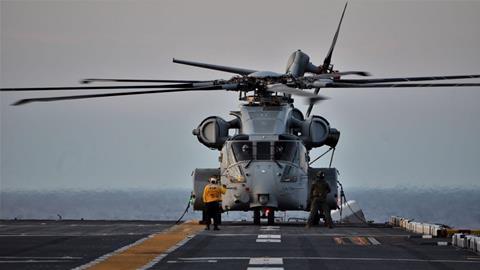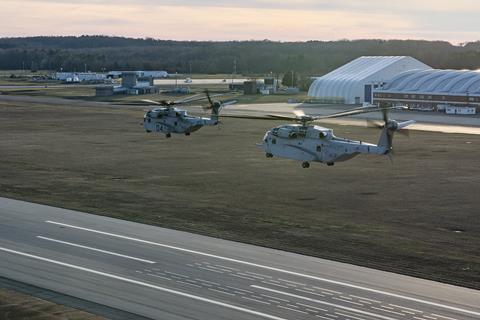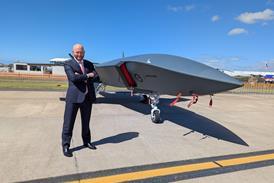The US Navy (USN) has approved full-rate production for the Sikorsky CH-53K King Stallion heavy-lift helicopter.
Lockheed Martin subsidiary Sikorsky said on 27 December the USN’s decision will increase annual production of the three-engined rotorcraft to 20 aircraft per year. The firm adds it is currently procuring long-lead items and “critical materials” to support full-rate production.

“Ramping up production of the most technologically advanced helicopter in the world allows the US Marine Corps [USMC] to build out its CH-53K King Stallion fleet and support mission success,” says Bill Falk, director of the Sikorsky CH-53K programme.
Falk adds the authorisation of full-rate production “stabilises Sikorsky’s domestic supply chain”. That network covers dozens of suppliers across 34 US states, according to Lockheed.
The CH-53K will replace the CH-53E Super Stallion as the USMC’s heavy-lift helicopter. The service declared initial operational capability on the type in April 2022.
The programme’s production milestone is major win for Sikorsky, which suffered a setback in December when the US Army selected Sikorsky competitor Bell to produce the service’s next-generation utility lift and assault helicopter, known as the Future Long Range Assault Aircraft. That role is currently filled by the Sikorsky UH-60 Black Hawk, of which the army operates some 2,300.
During an April 2022 tour of Sikorsky’s factory in Stratford, Connecticut, company president Paul Lemmo acknowledged failure to secure a contract would likely mean reductions to the Stratford plant’s 6,500-person workforce. The firm is still competing for the army’s Future Attack Reconnaissance Aircraft programme.
The USMC has a CH-53K acquisition objective of 200 aircraft, which Sikorsky says has been approved by defence officials. Cirium data indicates the service currently operates 140 Super Stallions.
The King Stallion is vastly more advanced than its predecessor, according to USMC Colonel Jack Perrin, a now retired test pilot and previously the USMC officer overseeing the CH-53K programme.
Speaking at the 2022 Navy League Sea-Air-Space conference last April, Perrin described the CH-53K as “the easiest airframe I’ve ever flown”, adding that he has flight time on 30 different fixed-wing and rotary aircraft.

The USMC originally awarded Lockheed Martin subsidiary Sikorsky the heavy lift contract for the CH-53K in 2006. The long-time helicopter manufacturer was charged with producing a heavy vertical lift platform to move armoured vehicles, troops and supplies from offshore assault ships to landing sites far inland.
The result is the USMC’s first conventional helicopter incorporating fully digital, fly-by-wire flight controls. The tiltrotor Bell Boeing V-22 Osprey, which the USMC fields, is also a fly-by-wire aircraft.
The King Stallion represents a significant improvement over its predecessor, Sikorsky says, boasting 57% more horsepower and 63% fewer parts. The Super Stallion was first fielded in 1988.
The basic requirements for the CH-53K were developed with a Pacific island campaign in mind, according to the USMC. The service wanted an aircraft capable of launching from a ship, lifting an external load of approximately 12,000kg (27,000lb) and transporting that load at least 110nm (204km) ashore before returning to the assault ship.
The load weight roughly corresponds to a USMC Light Amphibious Assault Vehicle, which weighs 11,400kg. The King Stallion uses three GE Aerospace T408 turboshafts, each rated at 7,500shp (5,520kW), to achieve that capability.
In addition to the USMC deal, Sikorsky is also under contract to deliver 12 CH-53Ks to the Israeli air force. Germany had been considering the King Stallion for its heavy lift needs, but in June 2022 opted instead for the Boeing CH-47 Chinook.














































